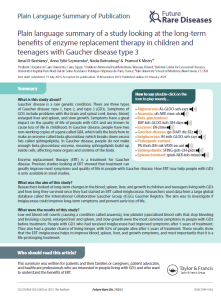Long-term benefits of enzyme replacement therapy in children and teenagers with Gaucher disease type 3- a plain language summary
 This Plain Language Summary of Publication article (PLSP) from Future Rare Diseases looks at the rare genetic condition, Gaucher disease type 3 (GD3). GD3 can affect children and cause brain and spinal cord symptoms such as involuntary eye movements, seizures, confusion and memory loss, and over-rounding of the upper back. The study described in this PLSP looked at long-term changes in the blood, spleen, liver, and growth in children and teenagers living with GD3, and how long they survived once they had started a type of treatment called imiglucerase.
This Plain Language Summary of Publication article (PLSP) from Future Rare Diseases looks at the rare genetic condition, Gaucher disease type 3 (GD3). GD3 can affect children and cause brain and spinal cord symptoms such as involuntary eye movements, seizures, confusion and memory loss, and over-rounding of the upper back. The study described in this PLSP looked at long-term changes in the blood, spleen, liver, and growth in children and teenagers living with GD3, and how long they survived once they had started a type of treatment called imiglucerase.
Visit the Future Medicine using the link to read the article.
This PLSP is based on an original article called ‘Long-term hematological, visceral, and growth outcomes in children with Gaucher disease type 3 treated with imiglucerase in the International Collaborative Gaucher Group Gaucher Registry’ and was published in Molecular Genetics and Metabolism.
Visit ScienceDirect using the link to read the article.
